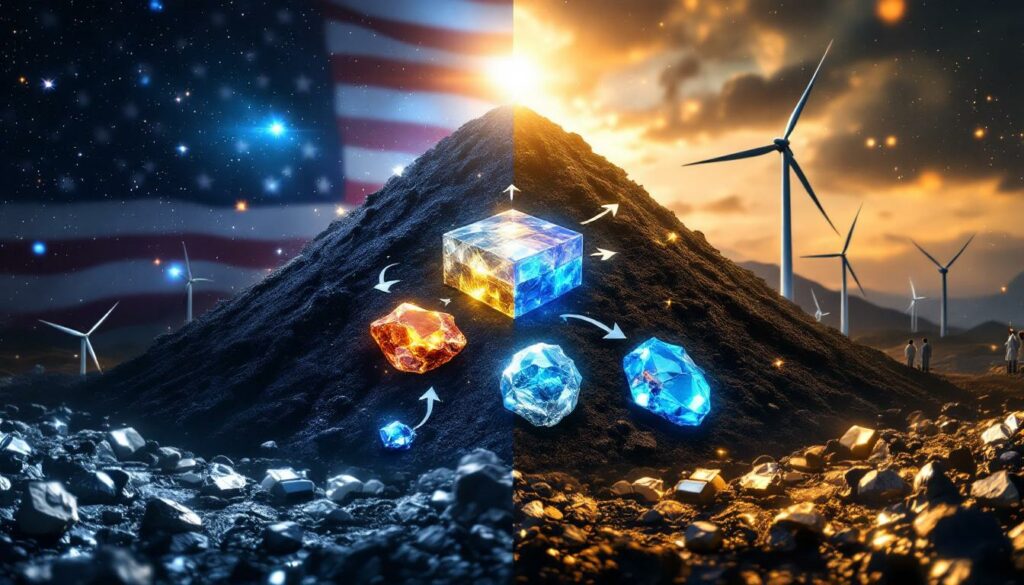What Are the Valuable Rare Earth Elements in Coal Ash?
Coal ash, once considered merely an industrial waste product, contains surprising concentrations of rare earth elements (REEs) that could transform America's critical minerals supply chains. These overlooked repositories may hold the key to reducing U.S. dependence on foreign sources while addressing environmental concerns.
The United States produces approximately 110 million tons of coal ash annually, creating an abundant potential source of critical materials. During coal combustion, organic matter burns away while minerals remain concentrated in the ash, naturally enhancing REE concentrations.
As Bridget Scanlon from the University of Texas at Austin notes, "This really exemplifies the 'trash to treasure' mantra… We're basically trying to close the cycle and use waste and recover resources."
These elements—including neodymium, dysprosium, yttrium, and others—are essential components in technologies ranging from smartphones to defense systems, making them strategically vital to critical minerals energy security and economic development.
How Much Rare Earth Material Is Hidden in U.S. Coal Ash?
The Remarkable Scale of the Resource
Recent research from the University of Texas at Austin has revealed that U.S. coal ash reserves potentially contain up to 11 million tons of rare earth elements. This represents approximately eight times the amount currently in U.S. reserves and could be valued at an estimated $8.4 billion. With the United States producing approximately 110 million tons of coal ash annually, this waste stream represents a significant untapped domestic resource.
According to UT Austin researchers, "Even though the level of rare earth elements in coal ash is relatively low… the ash is readily available in large quantities," making it a compelling alternative to traditional mining operations.
Regional Variations in REE Concentrations
Not all coal ash deposits contain equal concentrations of these valuable elements:
-
Appalachian Basin: Highest concentration at 431 milligrams per kilogram, but only 30% is easily recoverable
-
Powder River Basin: Lower concentration at 264 milligrams per kilogram, but with 70% extractability, making it potentially more economically viable
These variations stem from the different geological formations and coal types found across U.S. regions, creating unique opportunities and challenges for extraction efforts.
Why Are Rare Earth Elements So Critical?
Strategic Importance in Modern Technology
Rare earth elements play a crucial role in numerous high-tech applications:
-
Essential components in permanent magnets for electric vehicles and wind turbines
-
Critical materials for electronics, including smartphones and computers
-
Key ingredients in military defense systems and equipment
-
Necessary elements for various clean energy technologies
-
Vital components in medical equipment and diagnostic tools
The Department of Energy recognizes that these elements are irreplaceable in many applications due to their unique magnetic, luminescent, and electrochemical properties.
Current Supply Chain Vulnerabilities
The United States faces significant critical minerals supply chain challenges regarding rare earth elements:
-
Imports nearly 100% of rare earth elements consumed (USGS data, 2018)
-
80% of these imports come from China
-
China controls 38% of global raw rare earth mineral production
-
Chinese refineries dominate 85-90% of global rare earth processing
-
China also processes substantial portions of other critical minerals needed for clean energy
-
Chinese manufacturers produce the majority of EV batteries globally
The U.S. Department of Energy reports over 50% import reliance for critical minerals, with complete reliance on 14 minerals—creating substantial economic and national security vulnerabilities, particularly as trade tensions increase.
How Could Coal Ash Transform U.S. Mineral Security?
The "Trash to Treasure" Opportunity
Extracting rare earth elements from coal ash represents a dual-benefit approach:
-
Resource Recovery: Utilizing an abundant waste stream that already requires management
-
Environmental Remediation: Addressing potential contamination issues from coal ash ponds
-
Supply Chain Security: Developing domestic sources of critical minerals
-
Economic Development: Creating new industries and jobs in regions with coal ash deposits
-
Waste Reduction: Decreasing the volume of coal ash requiring long-term storage
Professor Sarma Pisupati from Penn State University emphasizes this dual benefit: "By modifying existing treatment processes, we can address… getting material for national security and remediating environmental problems."
Extraction Challenges and Technologies
Several approaches are being developed to extract rare earth elements from coal ash:
-
Acid leaching processes that selectively dissolve target elements
-
Physical separation techniques that concentrate REE-rich fractions
-
Chemical precipitation methods to isolate specific elements
-
Bioextraction using specialized microorganisms
-
Combined approaches that maximize recovery while minimizing environmental impacts
Each method presents different efficiency rates, environmental considerations, and capital requirements—factors that will determine commercial viability at scale.
What Environmental Benefits Could Result?
Addressing Coal Ash Storage Risks
Coal ash storage facilities present significant environmental hazards:
-
Risk of containment failures and spills into waterways
-
Potential groundwater contamination from unlined storage ponds
-
Airborne particulate concerns from dry ash storage
-
Long-term management costs and liabilities for utilities
With approximately 1,400 coal ash ponds across the United States, many of which are unlined, these repositories pose ongoing environmental challenges. By reprocessing coal ash for rare earth elements, these environmental risks could be substantially reduced while creating economic value.
Creating Circular Economy Solutions
Extracting rare earth elements from coal ash exemplifies circular economy principles:
-
Transforming waste streams into valuable resources
-
Reducing the need for new mining operations
-
Decreasing environmental impacts associated with primary extraction
-
Creating economic incentives for proper waste management solutions
-
Developing technologies applicable to other waste streams
As Bridget Scanlon notes, this approach focuses on "reducing environmental impacts while recovering resources"—a win-win for industry and communities affected by coal ash storage.
Which Industries Would Benefit Most?
Technology Manufacturing
Companies producing high-tech devices would gain from more secure and potentially more stable REE supply chains:
-
Computer and smartphone manufacturers
-
Electric vehicle producers
-
Renewable energy equipment makers
-
Defense contractors
-
Medical device companies
The stability of domestic supply could reduce price volatility and enhance manufacturing resilience, particularly important as demand for these elements continues to grow with the expansion of green technologies.
Energy Sector
The energy industry would benefit in multiple ways:
-
Coal power generators could transform liabilities (ash ponds) into assets
-
Renewable energy manufacturers would gain more secure supply chains
-
Utilities could reduce long-term storage and remediation costs
-
Energy transition efforts would face fewer supply constraints
For utilities still managing legacy coal ash sites, extraction technologies could convert environmental liabilities into revenue streams while addressing regulatory compliance requirements.
Mining and Processing Industries
New business opportunities would emerge for:
-
Companies specializing in secondary resource recovery
-
Mineral processing and refining operations
-
Environmental remediation firms
-
Technology developers focused on extraction methods
-
Transportation and logistics providers
These emerging opportunities could revitalize regional economies in areas with significant coal ash deposits, particularly in Appalachia and the Western United States.
How Does This Compare to Traditional Mining?
Economic Considerations
Extracting rare earth elements from coal ash offers several economic advantages compared to traditional mining:
| Factor | Traditional REE Mining | Coal Ash Extraction |
|---|---|---|
| Initial capital costs | Very high (new mine development) | Moderate (processing facility) |
| Resource concentration | Higher grade deposits | Lower concentrations but vast quantity |
| Processing complexity | Complex separation required | Similar separation challenges |
| Environmental permitting | Lengthy and challenging | Potentially streamlined (remediation aspect) |
| Infrastructure needs | Extensive new development | Often existing infrastructure |
| Supply chain security | Often in geopolitically sensitive regions | Domestic resource |
The economics become particularly favorable when factoring in the avoided costs of long-term ash storage and potential environmental liabilities.
Environmental Impact Comparison
From an environmental perspective, coal ash extraction presents several advantages:
-
Utilizes an existing waste stream rather than disturbing new land
-
Reduces environmental liabilities associated with coal ash storage
-
Potentially lower water usage compared to traditional mining
-
Smaller physical footprint than new mine development
-
Addresses existing environmental concerns while creating value
These benefits align with increasing environmental, social, and governance (ESG) requirements for mining operations and resource development projects.
What Steps Are Needed to Develop This Resource?
Research and Development Priorities
To fully realize the potential of coal ash as a rare earth element source:
-
Improve extraction efficiency and reduce processing costs
-
Develop scalable technologies for commercial implementation
-
Optimize recovery rates for specific elements based on market demand
-
Create environmentally sound processing methods
-
Establish quality standards for recovered materials
Research institutions like the University of Texas at Austin, which published their groundbreaking study in November 2024, continue to advance the science behind efficient extraction methodologies.
Policy and Regulatory Considerations
Government action could accelerate development through:
-
Research funding for extraction technology development
-
Tax incentives for coal ash processing facilities
-
Streamlined permitting for remediation-focused projects
-
Strategic mineral stockpile purchases from domestic sources
-
Support for demonstration projects and commercial scaling
Existing programs through the Department of Energy and other agencies could be expanded to specifically target coal ash REE recovery as a strategic priority.
Industry Collaboration Opportunities
Successful development will require partnerships across sectors:
-
Utilities that own coal ash repositories
-
Mining companies with mineral processing expertise
-
Technology firms developing extraction methods
-
End users of rare earth elements
-
Environmental remediation specialists
-
Academic research institutions
As Professor Pisupati emphasizes, these collaborations can achieve the dual goals of "recovering critical minerals… while remediating environmental problems."
What's the Timeline for Implementation?
Near-Term Possibilities (1-3 Years)
-
Completion of comprehensive resource assessments
-
Pilot-scale demonstration projects at select sites
-
Development of preliminary economic models
-
Regulatory framework adjustments to facilitate projects
-
Initial investment in commercial-scale facilities
Building on research like the USGS publication on rare earth elements in coal ash, these early-stage activities would validate the commercial potential and refine extraction approaches.
Medium-Term Developments (3-7 Years)
-
First commercial-scale processing facilities operational
-
Integration of recovered materials into supply chains
-
Refinement of extraction technologies based on operational experience
-
Expansion to additional coal ash repositories
-
Development of secondary processing capabilities
As technologies mature and early facilities demonstrate success, expansion to additional sites would accelerate, creating regional hubs for REE recovery.
Long-Term Vision (7+ Years)
-
Widespread implementation across major coal ash repositories
-
Significant contribution to domestic rare earth element supply
-
Advanced processing capabilities for high-purity materials
-
Integration with broader critical mineral strategy
-
Potential export of technology and expertise
Successful implementation could transform the United States from a net importer to a potential exporter of both REEs and the technologies to recover them from waste streams.
FAQs About Coal Ash and Rare Earth Elements
What exactly are rare earth elements?
Rare earth elements comprise 17 metallic elements on the periodic table, including 15 lanthanides plus scandium and yttrium. Despite their name, most aren't particularly rare in the Earth's crust, but they rarely occur in concentrated, economically viable deposits. They're prized for their unique magnetic, luminescent, and electrochemical properties.
How do rare earth elements end up in coal ash?
Coal forms from plant matter that has absorbed various elements from the surrounding environment over millions of years. During coal combustion, many minerals remain in the ash while organic components burn away, effectively concentrating these elements. The geological conditions that formed specific coal deposits determine which rare earth elements are present and in what concentrations.
Is extracting rare earth elements from coal ash economically viable?
Economic viability depends on several factors, including:
-
Concentration of rare earth elements in specific ash deposits
-
Extraction efficiency of available technologies
-
Market prices for the recovered elements
-
Processing costs and capital investment requirements
-
Potential co-benefits such as reduced storage liabilities
Current research suggests that with technological improvements and potential policy support, extraction could become economically viable, particularly when considering the strategic value of domestic supply.
How does this approach compare to recycling rare earth elements from electronic waste?
Both approaches represent complementary strategies for securing rare earth element supplies:
| Coal Ash Recovery | E-Waste Recycling |
|---|---|
| Vast quantities available | Limited by consumer disposal patterns |
| Lower concentration but consistent | Higher concentration but variable composition |
| Addresses existing environmental issue | Addresses growing waste stream |
| Requires new processing infrastructure | Can utilize some existing recycling channels |
| Potential for continuous processing | Collection logistics challenges |
A comprehensive approach to rare earth element security would likely include both strategies alongside traditional mining.
Conclusion: A Dual Opportunity for Resources and Remediation
The discovery of significant rare earth element concentrations in coal ash and rare earth elements represents a remarkable opportunity to address two pressing challenges simultaneously: securing critical mineral supply chains and managing a problematic waste stream. By developing the technologies and infrastructure to extract these valuable materials, the United States could reduce its dependence on foreign sources while transforming environmental liabilities into economic assets.
As research continues and extraction technologies improve, coal ash repositories may emerge as an important component of a more resilient, secure, and environmentally sound approach to meeting the growing demand for rare earth elements in our increasingly high-tech world. The transformation of this overlooked resource truly exemplifies the potential for innovative solutions at the intersection of resource security, environmental stewardship, and mine reclamation innovation.
"This really exemplifies the 'trash to treasure' mantra… We're basically trying to close the cycle and use waste and recover resources." — Bridget Scanlon, University of Texas at Austin
With an estimated 11 million tons of rare earth elements worth $8.4 billion potentially recoverable from U.S. coal ash, this abundant waste stream could become a cornerstone of domestic critical mineral supply—turning what was once considered worthless into a national strategic asset while supporting the expansion of renewable energy mining solutions.
Ready to Discover Your Next Major Mining Opportunity?
Don't miss the next significant ASX mineral discovery that could transform your portfolio. Visit Discovery Alert's discoveries page to see how their proprietary Discovery IQ model identifies high-potential opportunities before the broader market, and begin your 30-day free trial today.




